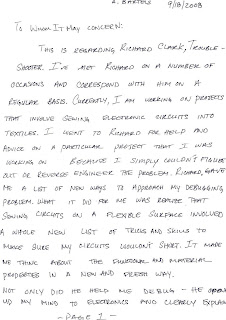My interest in electronics and textiles started about 8 years ago. As a student at the University of Washington, I attended a lecture by Marie O'Mahony, who had been invited by the Electrical Engineering Department, to speak about her work. I was a student in the Fiber Arts and Sculpture program and the bridge between textile and technology intrigued me (and it still does today). (At the time I had been experimenting with the BASIC Stamp and tinkering with music boxes and putting them in soft objects). The body of work she presented consisted of garments, with the wiring attached to them, which kinetically moved them into different forms. For example, she created a series of dresses and skirts in which the hems on them were raised using a series of circuits.
O’Mahony’s innovation was making garments kinetically move without the physical interaction of either the human wearing it or another individual using physical force to alter it. The work was presented in conjunction with her book "Techno Textiles". However, the technology used in these pieces, was awkward and distracting. Furthermore, it worked against the functionality of the pieces. The power supplies on the garments were large, heavy battery packs and they were not attached to the human forms or the garments. Rather, they lay at the side of the model, which only allowed the model stationary movements. The wiring was boldly exposed and it made the viewer wonder if this was the desired aesthetic or simply a sacrifice for the new kinetic movements. Despite these formal functional distractions, the work was still a breakthrough in wearable technology.
Wearable technology and computers will soon be commonplace. How our clothes technologically behave, along with aesthetical appearance, will factor in to how we choose what we want to wear.
Clothing is an extension of ourselves and plays a key role in how view ourselves and how others view us within the culture we operate in. Culturally speaking, clothing is a marker. It communicates an individual’s class, sex, economic status, mood, and subculture within a society.
And one can’t help but draw a conclusion between “e-textiles” and our culture’s interest in the cyborg.
The conceptualization and contemporary imagery of the cyborg is probably rooted in the past. It is possible that we first conceived of the image of a cyborg, in its infancy, when we began using prosthetics in medicine. The development of imagery of the cyborg assumed solid shapes, because those shapes were the most physically functional. Imagery and artistry of the cyborg, in the past, has typically assumed that the additions of computers and electronics would be in solid materials. The chip, attached to the board, was always a solid material with little fluidity. And wiring, of any complexity, had to be baked with solder onto a PCB.
What if we could make circuits fluid and flexible? What if we allowed the form of circuits to follow the body or the shape of the garment or textile?
Let's make the case for conductive thread. It is flexible, can be stitched or woven into a textile or garment. With a little ingenuity, we can also eliminate the need for solder. Most importantly, it eliminates the PCB. It allows the garment and the textile to maintain its form, drape and fall freely. By stitching/weaving into the garment we can produce a freely flowing circuit board.
Let’s make the case for conductive inks that can be silkscreened onto fabric. Silkscreening is already used in a variety of applications on PCBs. So, why not silk screen directly onto fabric and add electrical components to it? A screen, with a breadboard like grid, could be printed onto fabric. Individuals, or possibly the wearers themselves, could attach components and be the designers of their own electrical circuits. And this would allow one to interact and change the appearance of a garment.
Please explore the links below. Have fun! We’re just beginning…
Vincent Leclerc with
XS LABSBe sure to check out the
SKORPIONS project on this page!
MIT Media's lab on wearables.
Leah BuechleyLeah Buechley is a researcher that studies soft circuits specifically. She has tons of info for all experience and level types (novice to hacker) plus lots of good links for materials and kits.
SparkLab
Fashioning TechnologyThe work of
Anouk WipprechtFashion designer and artist
Hussein Chalayan.Joo Yoon Paek
New Brave World - Hybrid Scrapyard





 The switch is in the back and it is conductive velcro. The battery is a 3v lithium ion cell battery that is sewn into the shell and is hidden by the hat - which by the way is beautifully lined in a raspberry acetate.
The switch is in the back and it is conductive velcro. The battery is a 3v lithium ion cell battery that is sewn into the shell and is hidden by the hat - which by the way is beautifully lined in a raspberry acetate.
 The sparrow is a little pronounced for my tastes, so I think I will color her.
The sparrow is a little pronounced for my tastes, so I think I will color her.


















